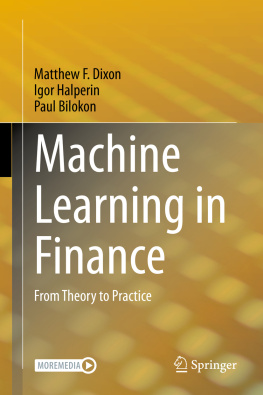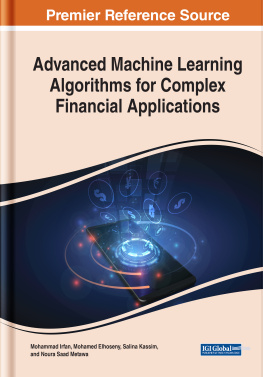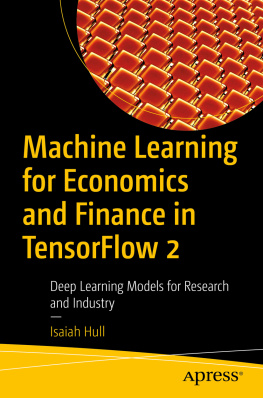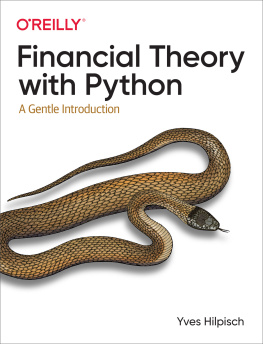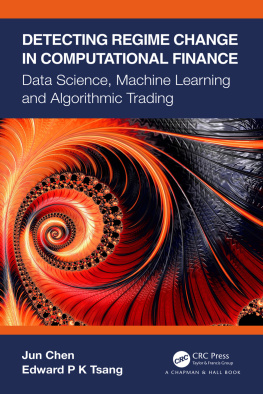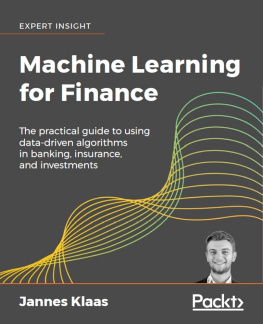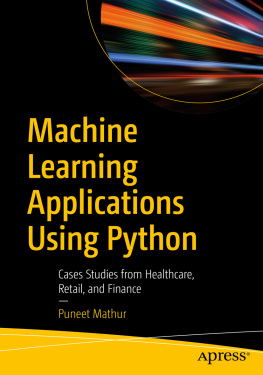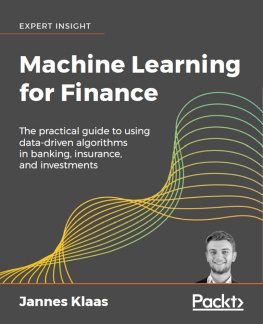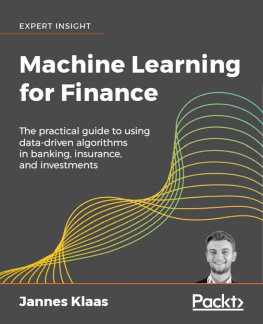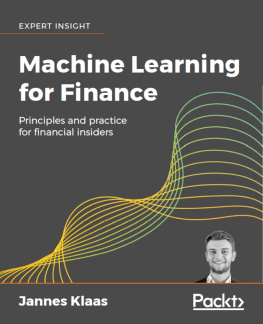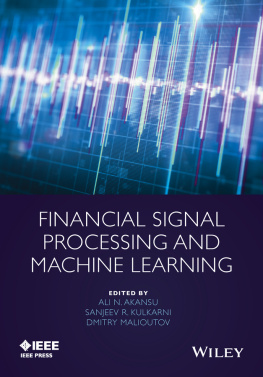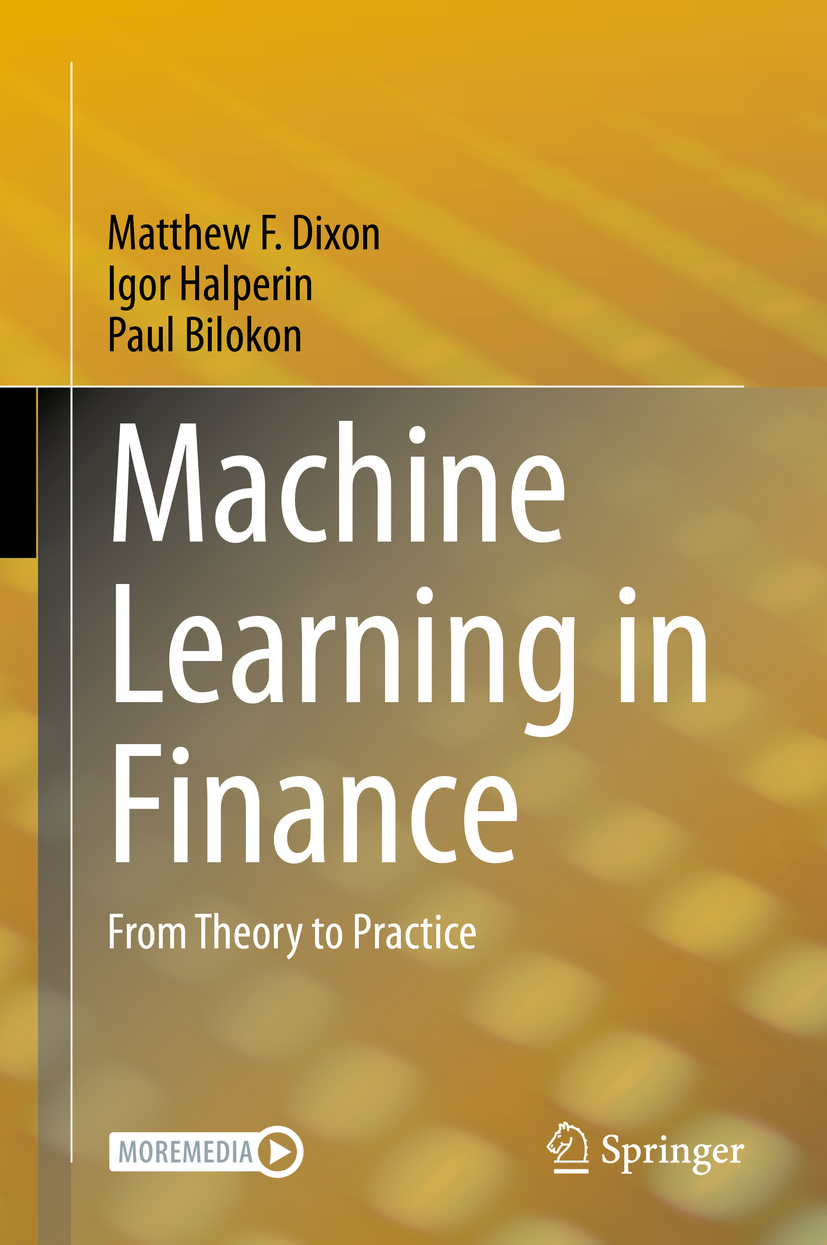Matthew F. Dixon
Department of Applied Mathematics, Illinois Institute of Technology, Chicago, IL, USA
Igor Halperin
Tandon School of Engineering, New York University, Brooklyn, NY, USA
Paul Bilokon
Department of Mathematics, Imperial College London, London, UK
Additional material to this book can be downloaded from http://mypages.iit.edu/~mdixon7/book/ML_Finance_Codes-Book.zip
ISBN 978-3-030-41067-4 e-ISBN 978-3-030-41068-1
https://doi.org/10.1007/978-3-030-41068-1
Springer Nature Switzerland AG 2020
This work is subject to copyright. All rights are reserved by the Publisher, whether the whole or part of the material is concerned, specifically the rights of translation, reprinting, reuse of illustrations, recitation, broadcasting, reproduction on microfilms or in any other physical way, and transmission or information storage and retrieval, electronic adaptation, computer software, or by similar or dissimilar methodology now known or hereafter developed.
The use of general descriptive names, registered names, trademarks, service marks, etc. in this publication does not imply, even in the absence of a specific statement, that such names are exempt from the relevant protective laws and regulations and therefore free for general use.
The publisher, the authors and the editors are safe to assume that the advice and information in this book are believed to be true and accurate at the date of publication. Neither the publisher nor the authors or the editors give a warranty, expressed or implied, with respect to the material contained herein or for any errors or omissions that may have been made. The publisher remains neutral with regard to jurisdictional claims in published maps and institutional affiliations.
This Springer imprint is published by the registered company Springer Nature Switzerland AG
The registered company address is: Gewerbestrasse 11, 6330 Cham, Switzerland
Introduction
Machine learning in finance sits at the intersection of a number of emergent and established disciplines including pattern recognition, financial econometrics, statistical computing, probabilistic programming, and dynamic programming. With the trend towards increasing computational resources and larger datasets, machine learning has grown into a central computational engineering field, with an emphasis placed on plug-and-play algorithms made available through open-source machine learning toolkits. Algorithm focused areas of finance, such as algorithmic trading have been the primary adopters of this technology. But outside of engineering-based research groups and business activities, much of the field remains a mystery.
A key barrier to understanding machine learning for non-engineering students and practitioners is the absence of the well-established theories and concepts that financial time series analysis equips us with. These serve as the basis for the development of financial modeling intuition and scientific reasoning. Moreover, machine learning is heavily entrenched in engineering ontology, which makes developments in the field somewhat intellectually inaccessible for students, academics, and finance practitioners from the quantitative disciplines such as mathematics, statistics, physics, and economics. Consequently, there is a great deal of misconception and limited understanding of the capacity of this field. While machine learning techniques are often effective, they remain poorly understood and are often mathematically indefensible. How do we place key concepts in the field of machine learning in the context of more foundational theory in time series analysis, econometrics, and mathematical statistics? Under which simplifying conditions are advanced machine learning techniques such as deep neural networks mathematically equivalent to well-known statistical models such as linear regression? How should we reason about the perceived benefits of using advanced machine learning methods over more traditional econometrics methods, for different financial applications? What theory supports the application of machine learning to problems in financial modeling? How does reinforcement learning provide a model-free approach to the BlackScholesMerton model for derivative pricing? How does Q-learning generalize discrete-time stochastic control problems in finance?
This book is written for advanced graduate students and academics in financial econometrics, management science, and applied statistics, in addition to quants and data scientists in the field of quantitative finance. We present machine learning as a non-linear extension of various topics in quantitative economics such as financial econometrics and dynamic programming, with an emphasis on novel algorithmic representations of data, regularization, and techniques for controlling the bias-variance tradeoff leading to improved out-of-sample forecasting. The book is presented in three parts, each part covering theory and applications. The first part presents supervised learning for cross-sectional data from both a Bayesian and frequentist perspective. The more advanced material places a firm emphasis on neural networks, including deep learning, as well as Gaussian processes, with examples in investment management and derivatives. The second part covers supervised learning for time series data, arguably the most common data type used in finance with examples in trading, stochastic volatility, and fixed income modeling. Finally, the third part covers reinforcement learning and its applications in trading, investment, and wealth management. We provide Python code examples to support the readers understanding of the methodologies and applications. As a bridge to research in this emergent field, we present the frontiers of machine learning in finance from a researchers perspective, highlighting how many well-known concepts in statistical physics are likely to emerge as research topics for machine learning in finance.
Prerequisites
This book is targeted at graduate students in data science, mathematical finance, financial engineering, and operations research seeking a career in quantitative finance, data science, analytics, and fintech. Students are expected to have completed upper section undergraduate courses in linear algebra, multivariate calculus, advanced probability theory and stochastic processes, statistics for time series (econometrics), and gained some basic introduction to numerical optimization and computational mathematics. Students shall find the later chapters of this book, on reinforcement learning, more accessible with some background in investment science. Students should also have prior experience with Python programming and, ideally, taken a course in computational finance and introductory machine learning. The material in this book is more mathematical and less engineering focused than most courses on machine learning, and for this reason we recommend reviewing the recent book, Linear Algebra and Learning from Data

